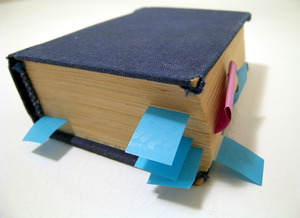As a software engineer who has been managing a consulting/web application business for the past twelve years I have received a wide variety of jobs and have worked with Microsoft Office products on a daily basis. The other day I got an interesting and very unique (for me) request from one of my clients. She wanted a book she had written indexed for print and e-book format. She asked me to perform this task for her for several reasons. First, we have worked together in the past. But most importantly, she felt that with the combination of writing skills plus technical ability I would be able to complete this project in a timely manner.
I readily agreed to the project because, well, it is something different. Indexing a book is something out of my ordinary realm of creating websites and I welcomed the change and the challenge.
The project is a 550 page plus bread machine recipe book and my client wanted all the ingredients indexed; except of course, the items that most people have in their kitchen, like flour. So off we went. First, in an effort to keep the project cost to a minimum, I taught her how to mark the items she wants to index in Microsoft Word 2010. It really is quite simple. Just follow these steps:
MARK INDEX ITEMS USING A MOUSE
1. Highlight text you want to include in the index.
2. Select the “References” tab in the toolbar ribbon.
3. Click “Mark Entry” located in the “Index” section of the “References” tab.
4. Repeat Steps 1 through 3 for each index item you wish to include. If you wish to create index entries that span multiple pages, proceed to the next step; otherwise skip to the next section.
5. Highlight the text spanning multiple pages you want to include in the index.
6. Select the “Insert” tab in the toolbar ribbon.
7. Click “Bookmark,” located in the “Links” section of the “Insert” tab and enter a name for the reference item spanning multiple pages.
8. Place your cursor at the end of the text you just bookmarked.
9. Select the “References” tab in the toolbar ribbon.
10. Click “Mark Entry” and enter a name for the index item.
11. Select the “Options” tab and click “Page Range.”
12. Select the bookmark item you created in Step 7 and then click “Mark.”
13. Repeat steps 5 through 12 to add additional multipage items to the index.
MARK INDEX ITEMS USING THE KEYBOARD
For those people who prefer to use keyboard shortcuts and look like a computer guru
1. Highlight text you want to include in the index.
2. Hit ALT-SHIFT-X
3. Repeat Steps 1 and 2 for each index item you wish to include. If you wish to create index entries that span multiple pages, proceed to the next step; otherwise skip to the next section.
4. Highlight the text spanning multiple pages you want to include in the index.
5. Select the “Insert” tab in the toolbar ribbon.
6. Click “Bookmark,” located in the “Links” section of the “Insert” tab and enter a name for the reference item spanning multiple pages.
7. Place your cursor at the end of the text you just bookmarked.
8. Hit ALT-SHIFT-X
9. Enter a name for the index range
10. Select the “Options” tab and click “Page Range.”
11. Select the bookmark item you created in Step 7 and then click “Mark.”
12. Repeat steps 4 through 11 to add additional multipage items to the index.
So, after teaching my client how to do the hard part of the index, I then went to work at creating the actual index – print version first.
1. Place your cursor on the page where you want the index to begin.
2. Select the “References” tab in the toolbar ribbon.
3. Click “Insert Index” located in the “Index” section of the “References” tab.
Okay. I realize I got the easy end of the work on this part of the project. The difficult part of producing the index for the e-book will come in Part II and will require a bit more effort on my part since Microsoft Word does not create a hyperlinked index automatically.



